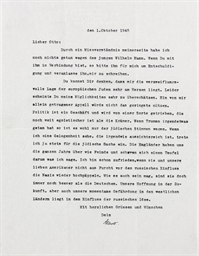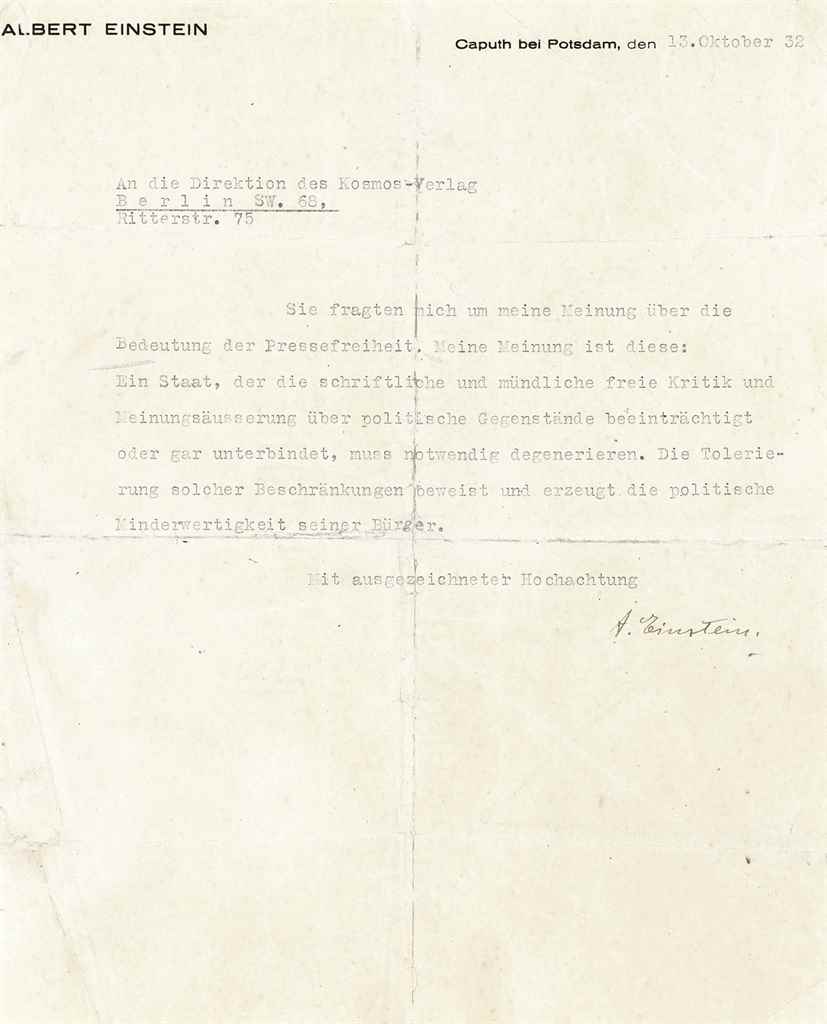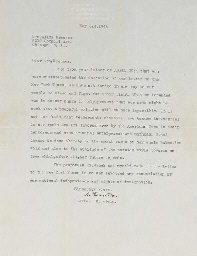EINSTEIN, ALBERT. Typed letter signed ("A. Einstein") to the physicist Robert S. Shankland, Princeton, N.J., 31 August 1954. 1 full page, 4to, on Institute for Advanced Study stationery. EINSTEIN RESPONDS TO NEWS THAT THE CONTROVERSIAL MILLER EXPERIMENTS OF 1925 DO NOT CHALLENGE, BUT MAY CONFIRM, THE THEORY OF RELATIVITY An important scientific letter bearing on a crucial experiment by the physicist Dayton C. Miller (1866-1941) whose announcement of his findings in 1921 had elicited from Einstein the famous remark "God is subtle, but he is not malicious" (see R. Clark, Einstein , p.473). Einstein has received from Shankland news of his reinterpretation of the data from Miller's old experiment (results later published as "New Analysis of the Inferometer Observations of Dayton C. Miller," in Reviews of Modern Physics , April 1955). Shankland's findings contradicted Miller's interpretation and instead tended to confirm Einstein's Theory of Relativity. Miller had sought to verify the existence of "ether" (a medium which filled outer space, by which light was transmitted), whose existence had been postulated by William Maxwell and tested in the famous Michelson-Morley experiments. Following observations of the the 1919 eclipse which apparently confirmed Einstein's Theory of Relativity, Miller conducted his experiments at Mt. Wilson Observatory. As Shankland elsewhere wrote, Miller announced that his results confirmed "the existence of an ether," but Shankland's "computer analysis of this great body of data after Miller's death proved that... they were not due to an ether-drift...When Miller's data were reanalyzed...they were shown to support the postulates of the special theory of relativity...." But while Einstein and others had long questioned the accuracy of Miller's expertimental results, it had nevertheless encouraged sceptics of the Theory of Relativity. Einstein's tone is grateful: "I thank you very much for sending me your careful study about the Miller experiments. Those experiments, conducted with so much care, merit, of course, a very careful statistical investigation. This is the more so as the existence of a not trivial positive effect would affect very deeply the fundament of theoretical physics [the Theory of Relativity] as it is presently accepted. You have shown convincingly that the observed effect is outside the range of accidental deviations and must, therefore, have a systematic cause. You made it quite probable that this systematic cause has nothing to do with "ether-wind", traversed by the two light bundles which produced the bands of interference. Such an effect is indeed practically inevitable if the walls of the laboratory room have a not negligible difference in temperature. It is one of the cases where the systematic errors are increasing quickly with the dimension of the apparatus...." He closes with congratulations to Shankland and his colleagues "on your valuable contribution to our knowledge" and notes that he has been unwell.
EINSTEIN, ALBERT. Typed letter signed ("A. Einstein") to the physicist Robert S. Shankland, Princeton, N.J., 31 August 1954. 1 full page, 4to, on Institute for Advanced Study stationery. EINSTEIN RESPONDS TO NEWS THAT THE CONTROVERSIAL MILLER EXPERIMENTS OF 1925 DO NOT CHALLENGE, BUT MAY CONFIRM, THE THEORY OF RELATIVITY An important scientific letter bearing on a crucial experiment by the physicist Dayton C. Miller (1866-1941) whose announcement of his findings in 1921 had elicited from Einstein the famous remark "God is subtle, but he is not malicious" (see R. Clark, Einstein , p.473). Einstein has received from Shankland news of his reinterpretation of the data from Miller's old experiment (results later published as "New Analysis of the Inferometer Observations of Dayton C. Miller," in Reviews of Modern Physics , April 1955). Shankland's findings contradicted Miller's interpretation and instead tended to confirm Einstein's Theory of Relativity. Miller had sought to verify the existence of "ether" (a medium which filled outer space, by which light was transmitted), whose existence had been postulated by William Maxwell and tested in the famous Michelson-Morley experiments. Following observations of the the 1919 eclipse which apparently confirmed Einstein's Theory of Relativity, Miller conducted his experiments at Mt. Wilson Observatory. As Shankland elsewhere wrote, Miller announced that his results confirmed "the existence of an ether," but Shankland's "computer analysis of this great body of data after Miller's death proved that... they were not due to an ether-drift...When Miller's data were reanalyzed...they were shown to support the postulates of the special theory of relativity...." But while Einstein and others had long questioned the accuracy of Miller's expertimental results, it had nevertheless encouraged sceptics of the Theory of Relativity. Einstein's tone is grateful: "I thank you very much for sending me your careful study about the Miller experiments. Those experiments, conducted with so much care, merit, of course, a very careful statistical investigation. This is the more so as the existence of a not trivial positive effect would affect very deeply the fundament of theoretical physics [the Theory of Relativity] as it is presently accepted. You have shown convincingly that the observed effect is outside the range of accidental deviations and must, therefore, have a systematic cause. You made it quite probable that this systematic cause has nothing to do with "ether-wind", traversed by the two light bundles which produced the bands of interference. Such an effect is indeed practically inevitable if the walls of the laboratory room have a not negligible difference in temperature. It is one of the cases where the systematic errors are increasing quickly with the dimension of the apparatus...." He closes with congratulations to Shankland and his colleagues "on your valuable contribution to our knowledge" and notes that he has been unwell.















Try LotSearch and its premium features for 7 days - without any costs!
Be notified automatically about new items in upcoming auctions.
Create an alert